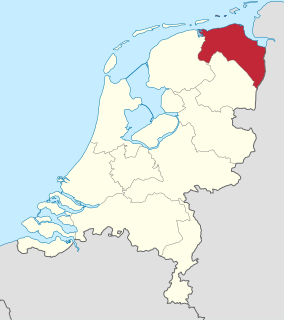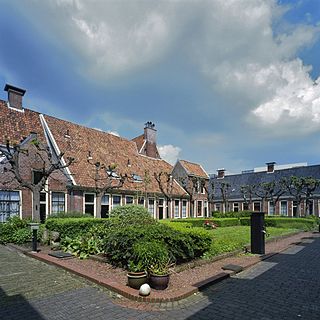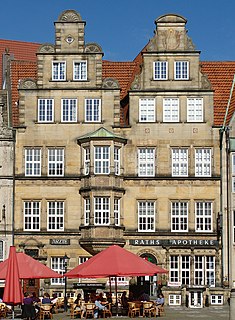
| Dutch Rijksmonument 18467 |
| Wikimedia Commons has media related to Goudkantoor (Groningen) . |
The Goudkantoor (English: Gold Office) is a building built in 1635 and located on Waagstraat near the Grote Markt (Main Square) in Groningen, Netherlands. Originally it was built as an office for the receiver of the province of Groningen when it was called Collectehuis.

The Netherlands, sometimes incorrectly called Holland, is a country located in Northwestern Europe with some overseas territories in the Caribbean. In Europe, it consists of 12 provinces that border Germany to the east, Belgium to the south, and the North Sea to the northwest, with maritime borders in the North Sea with those countries and the United Kingdom. Together with three island territories in the Caribbean Sea—Bonaire, Sint Eustatius and Saba—it forms a constituent country of the Kingdom of the Netherlands. The official language is Dutch, but a secondary official language in the province of Friesland is West Frisian. In the northern parts of the country, Low German is also spoken.

Groningen is the northeasternmost province of the Netherlands. It borders on Friesland to the west, Drenthe to the south, the German state of Lower Saxony to the east, and the Wadden Sea to the north. In 2014, it had a population of 582,640 and a total area of 2,960 km2 (1,140 sq mi).
The text on the building, Date Caesari quae sunt Caesaris (Latin) (English: Render unto Caesar that which is Caesar's) refers to the original function. The coat of arms of the city of Groningen is located on the building.

Latin is a classical language belonging to the Italic branch of the Indo-European languages. The Latin alphabet is derived from the Etruscan and Greek alphabets and ultimately from the Phoenician alphabet.

English is a West Germanic language that was first spoken in early medieval England and eventually became a global lingua franca. It is named after the Angles, one of the Germanic tribes that migrated to the area of Great Britain that later took their name, as England. Both names derive from Anglia, a peninsula in the Baltic Sea. The language is closely related to Frisian and Low Saxon, and its vocabulary has been significantly influenced by other Germanic languages, particularly Norse, and to a greater extent by Latin and French.

A coat of arms is a heraldic visual design on an escutcheon, surcoat, or tabard. The coat of arms on an escutcheon forms the central element of the full heraldic achievement which in its whole consists of shield, supporters, crest, and motto. A coat of arms is traditionally unique to an individual person, family, state, organization or corporation.
The name Goudkantoor goes back to 1814-1887, when the Waarborgbureau voor Goud- en Zilverwerken was located in the building. Gold and silver could get a hallmark so people could prove it was real.

Gold is a chemical element with the symbol Au and atomic number 79, making it one of the higher atomic number elements that occur naturally. In its purest form, it is a bright, slightly reddish yellow, dense, soft, malleable, and ductile metal. Chemically, gold is a transition metal and a group 11 element. It is one of the least reactive chemical elements and is solid under standard conditions. Gold often occurs in free elemental (native) form, as nuggets or grains, in rocks, in veins, and in alluvial deposits. It occurs in a solid solution series with the native element silver and also naturally alloyed with copper and palladium. Less commonly, it occurs in minerals as gold compounds, often with tellurium.

Silver is a chemical element with the symbol Ag and atomic number 47. A soft, white, lustrous transition metal, it exhibits the highest electrical conductivity, thermal conductivity, and reflectivity of any metal. The metal is found in the Earth's crust in the pure, free elemental form, as an alloy with gold and other metals, and in minerals such as argentite and chlorargyrite. Most silver is produced as a byproduct of copper, gold, lead, and zinc refining.
A hallmark is an official mark or series of marks struck on items made of metal, mostly to certify the content of noble metals—such as platinum, gold, silver and in some nations, palladium. In a more general sense, the term hallmark can also be used to refer to any distinguishing characteristic.
Prior to World War II the Northern Ship Transport was located in the building. Just before the liberation of the city, in April 1945, the entire collection was transferred to a building on the north side of the Grote Markt, because the owners were afraid that the Goudkantoor would get damaged during the liberation, but in fact it was one of the few buildings that wasn't heavily damaged, because fire-fighters saved it from burning down. [1]

World War II, also known as the Second World War, was a global war that lasted from 1939 to 1945. The vast majority of the world's countries—including all the great powers—eventually formed two opposing military alliances: the Allies and the Axis. A state of total war emerged, directly involving more than 100 million people from more than 30 countries. The major participants threw their entire economic, industrial, and scientific capabilities behind the war effort, blurring the distinction between civilian and military resources. World War II was the deadliest conflict in human history, marked by 70 to 85 million fatalities, most of whom were civilians in the Soviet Union and China. It included massacres, the genocide of the Holocaust, strategic bombing, premeditated death from starvation and disease, and the only use of nuclear weapons in war.

The Battle of Groningen took place during the penultimate month of Second World War in Europe, from April 14 to 18, 1945, in the city of Groningen between a mixture of German soldiers, Dutch and Belgian SS troops numbering 7,000 against the entire 2nd Canadian Infantry Division, though the whole division was never in combat at any given time. There were also substantial amounts of Luftwaffe units manning flak guns in the area. Groningen was also the site of the headquarters for the Sicherheitsdienst in the North of the Netherlands. The German command structure was poor and the defenders had never exercised together.
After the war, the museum was located in the building again for a short time and later it was used as an information centre (Het Stadjershuis) and as a tourist information centre. The Goudkantoor was restored during the construction of the Nieuwe Waagstraat and is currently a restaurant. [2]

















